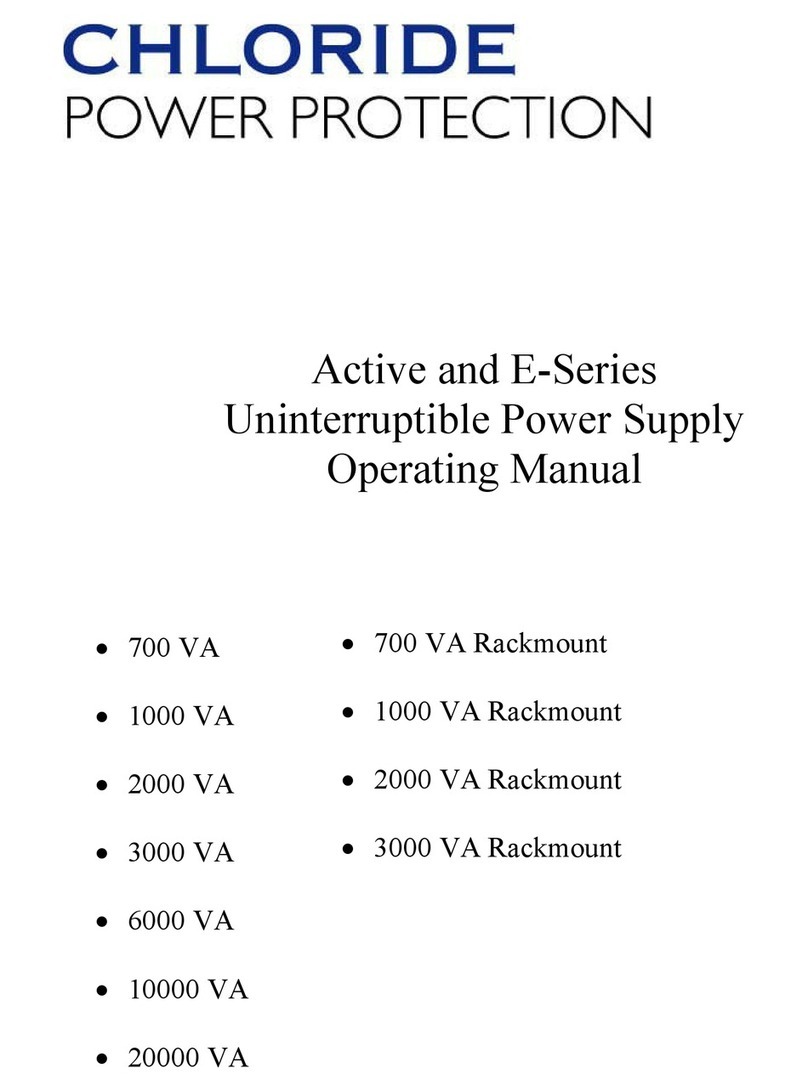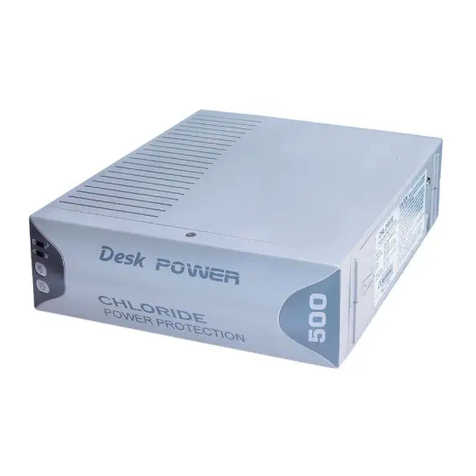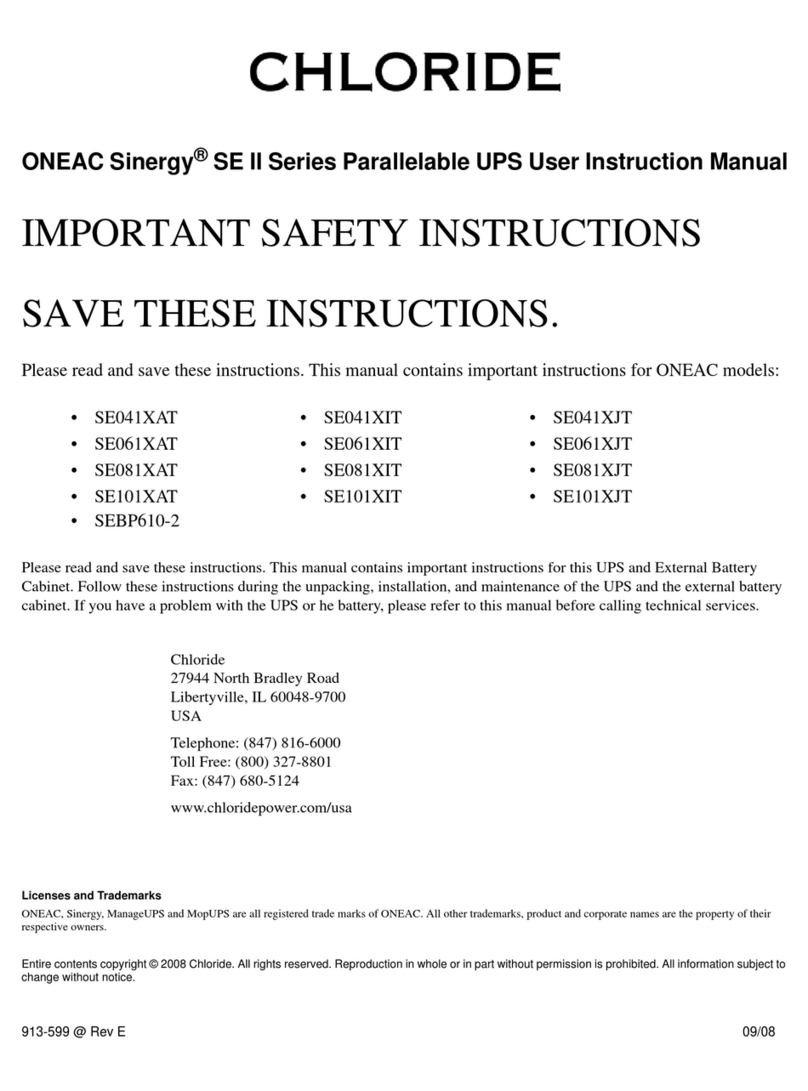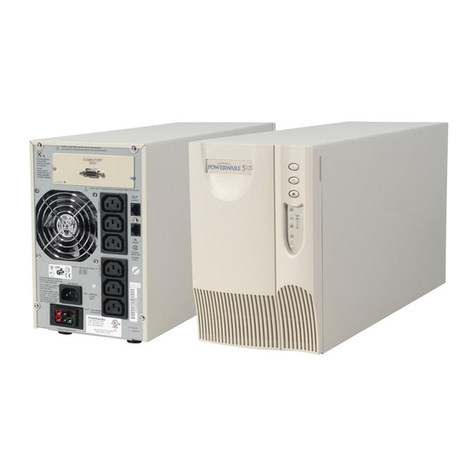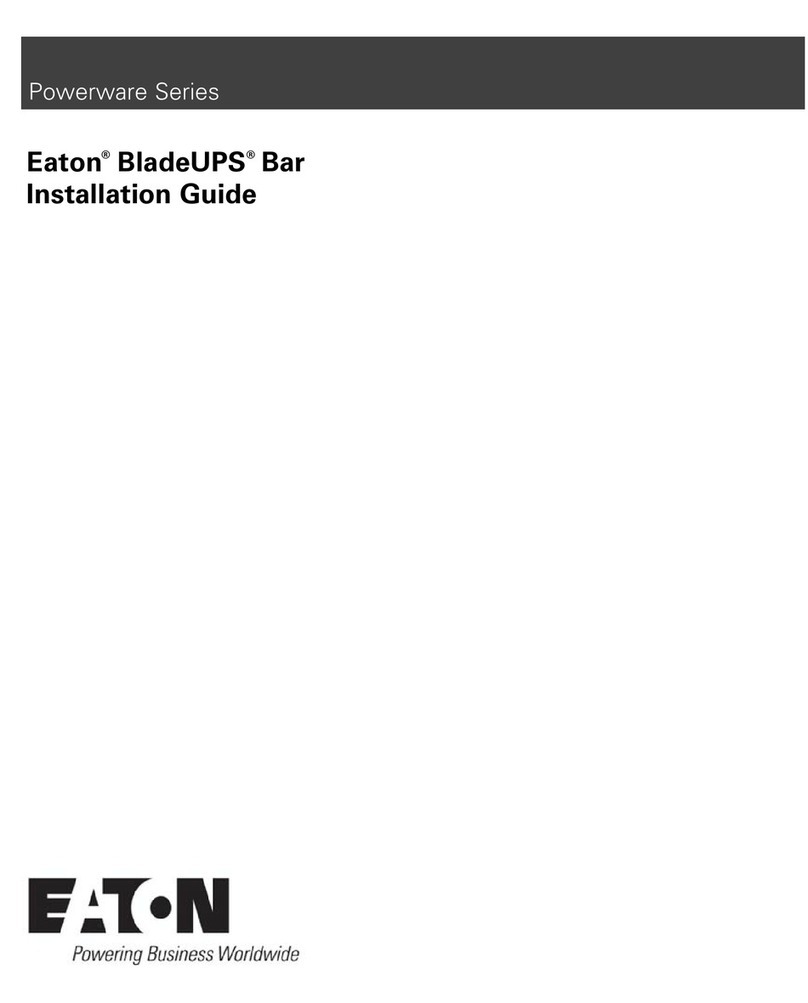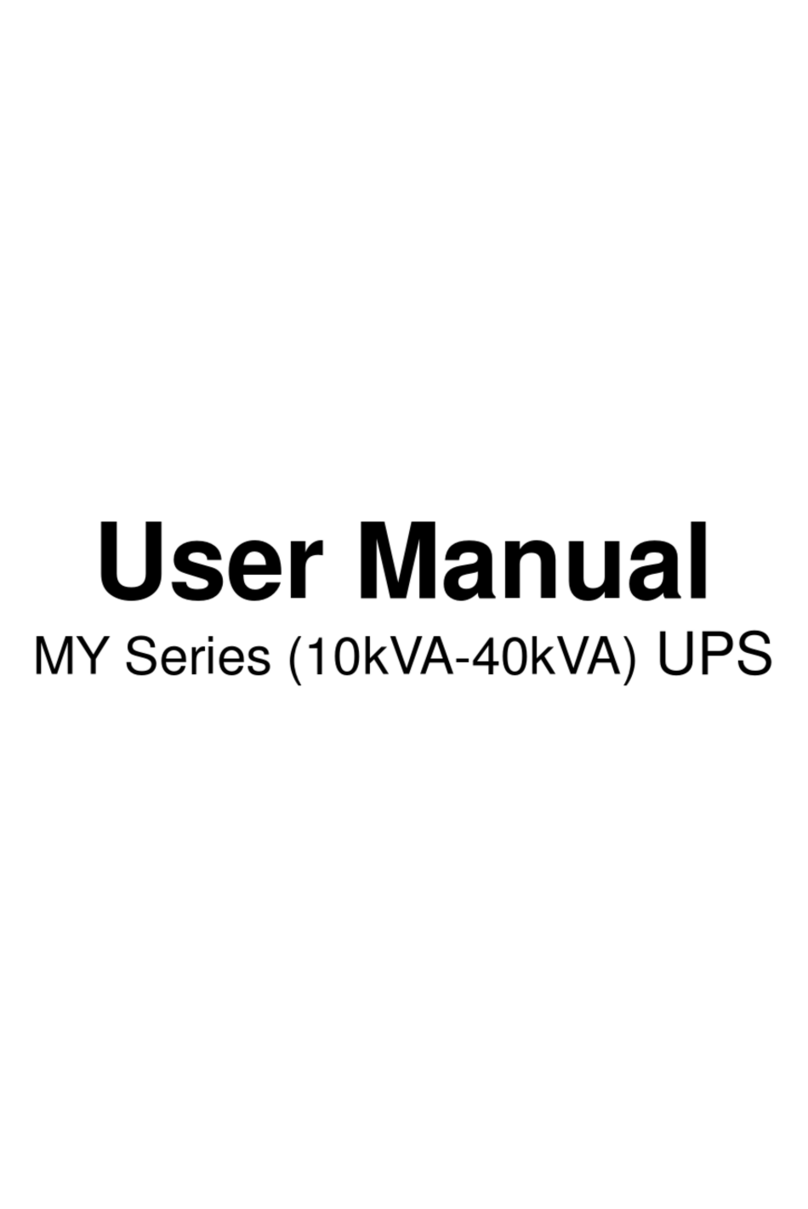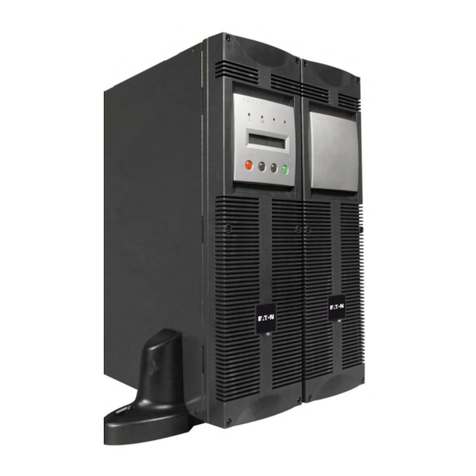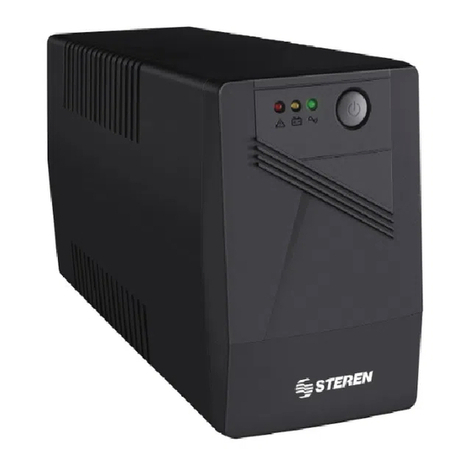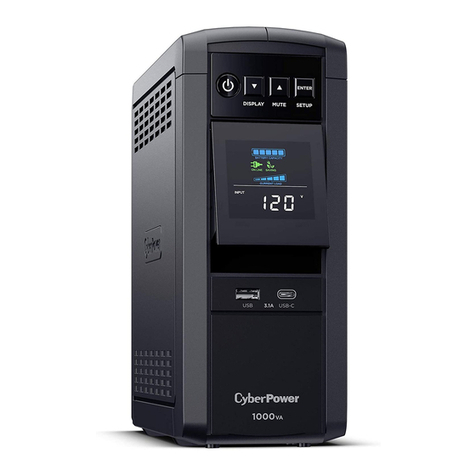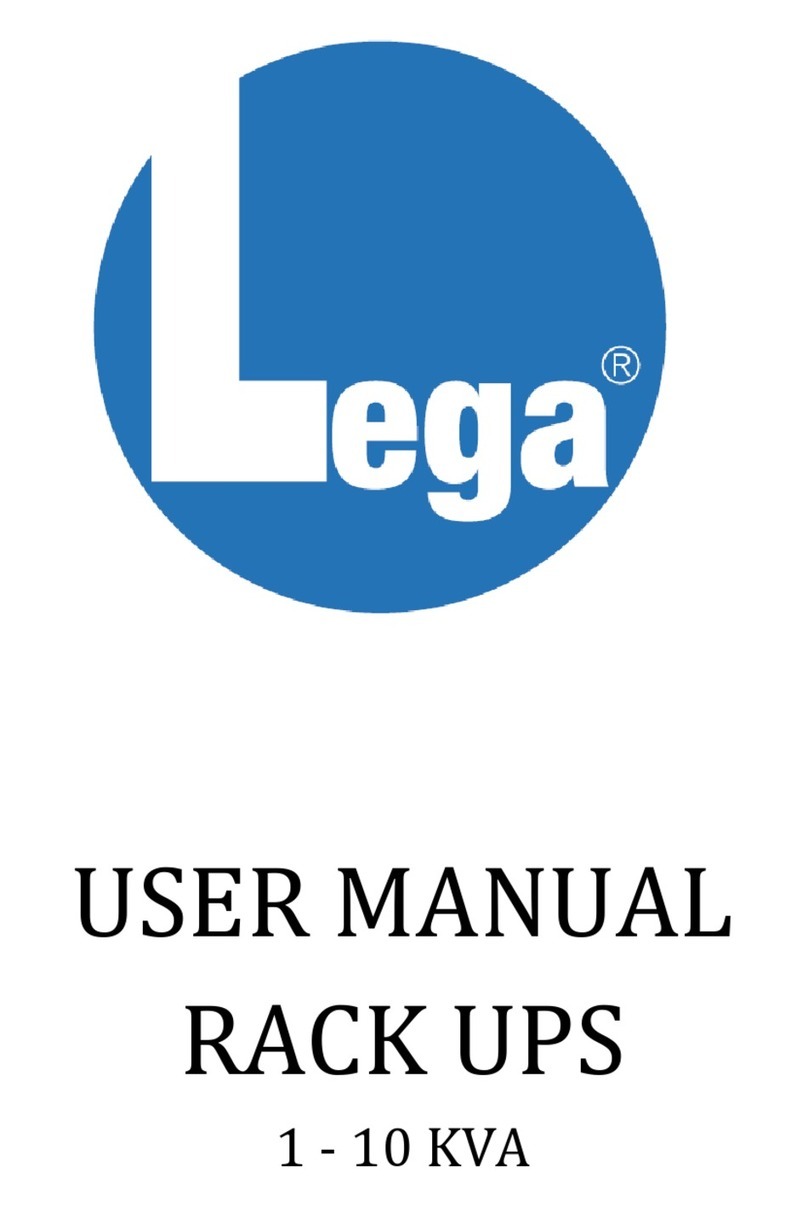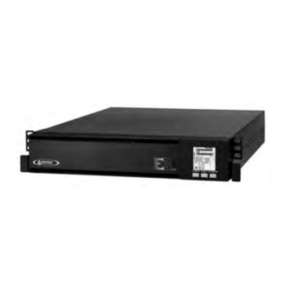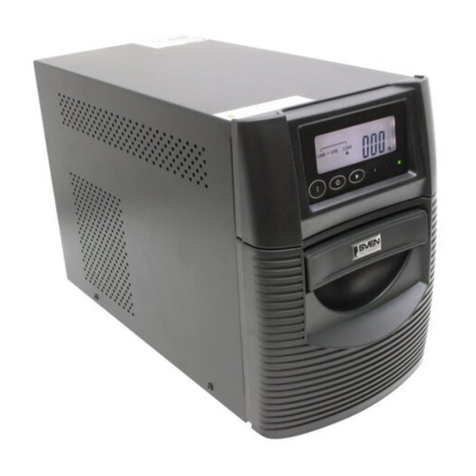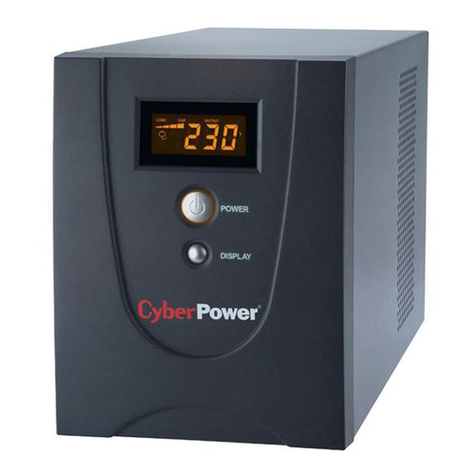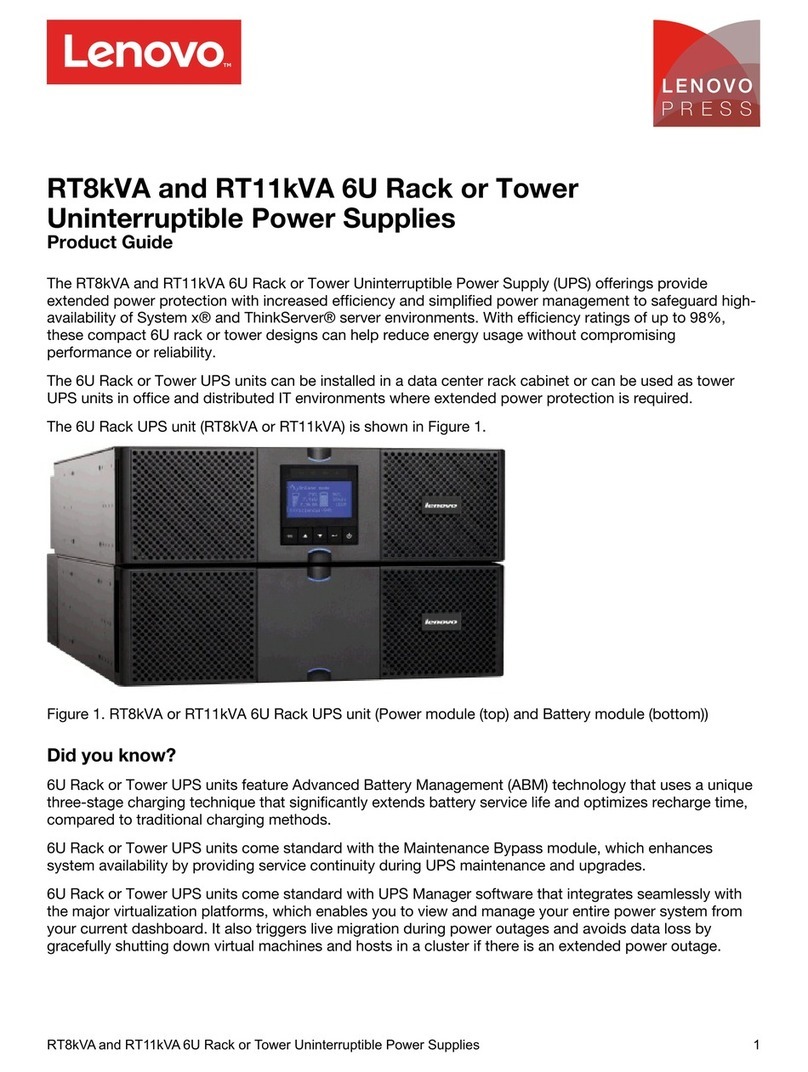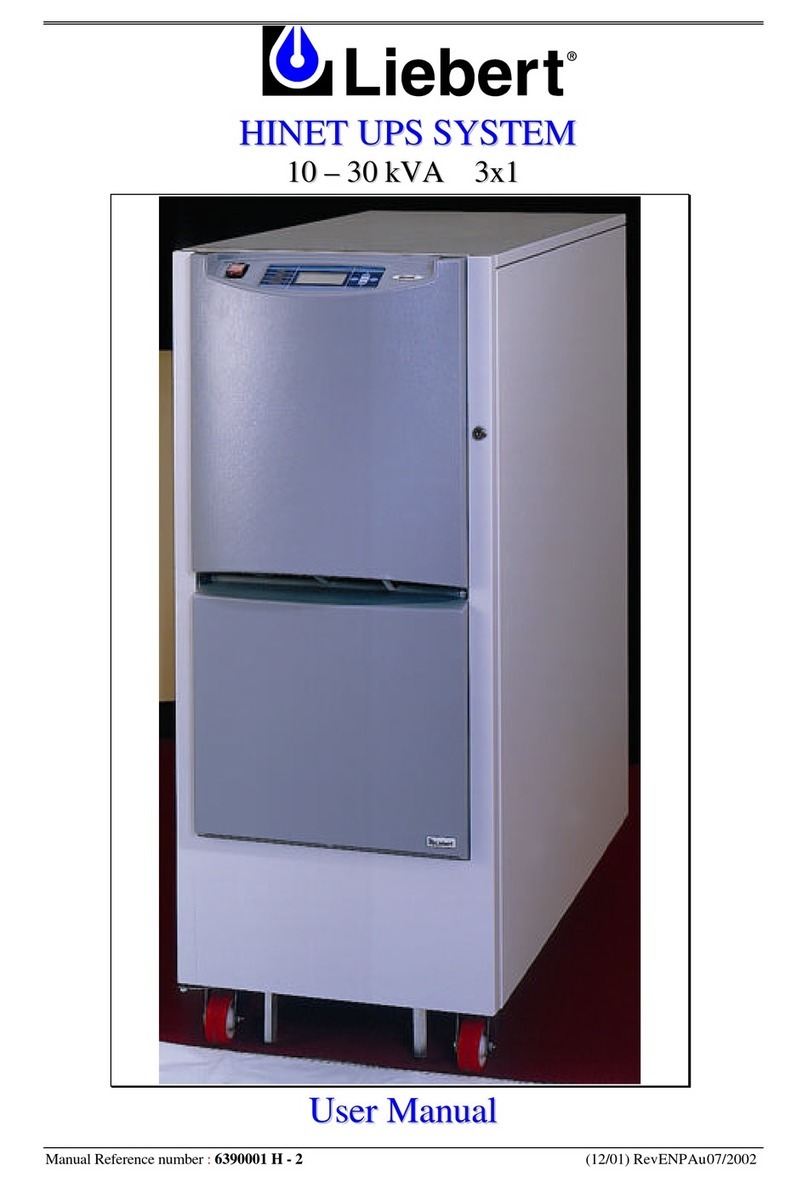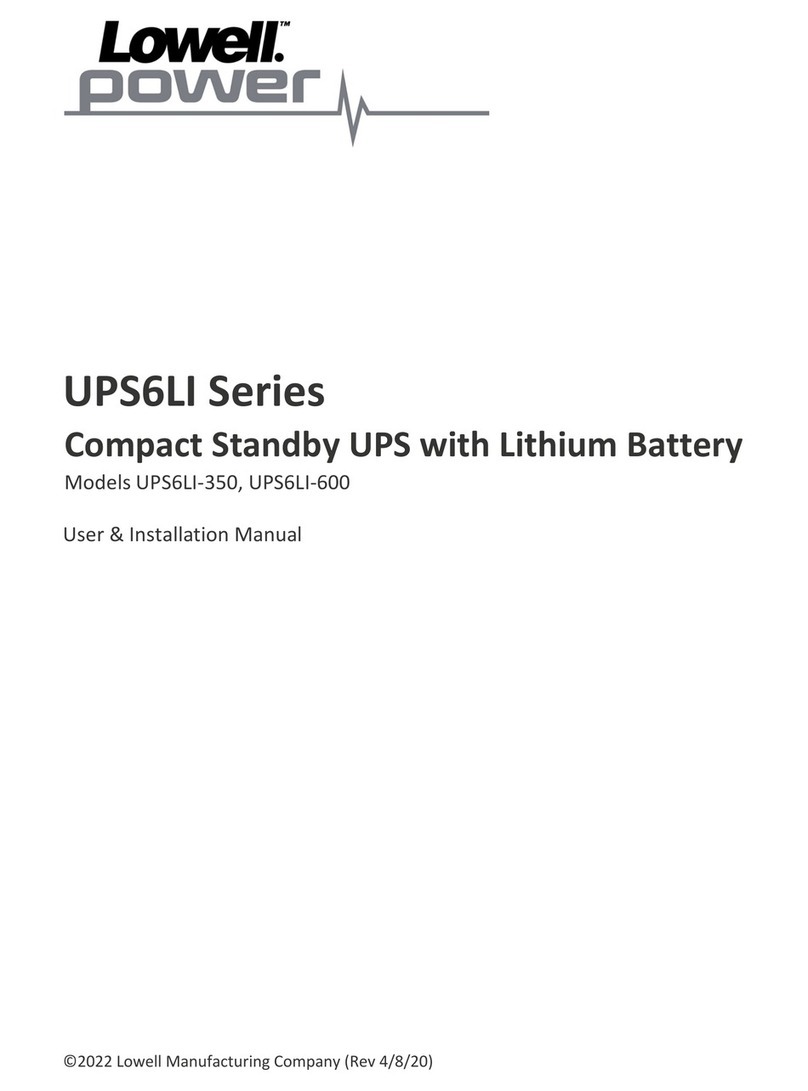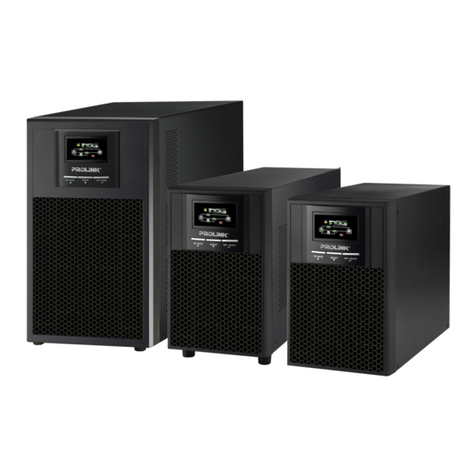Chloride CP3150 Series User manual

CHLORIDE POWER PROTECTION
THREE-PHASE Uninterruptible Power System
Owner’s Manual
CP3150
Series
P/N 913-576 Re
v
A

ii
User and Operating Manual
Chloride Power Protection
28430 North Ballard Drive • Lake Forest • IL • 60045
Toll Free Phone 800-239-2257 • Toll Free Fax 800-833-6829
Phone 847-990-3228 • Fax 847-549-7917

iii
DECLARATION OF CONFORMITY
The manufacturer: CHLORIDE POWER PROTECTION
Head office at:
28430 North Ballard Drive
Lake Forest, IL 60045
USA
HEREBY DECLARES THAT THE PRODUCT: CP3000
CONFORMS TO THE FOLLOWING REGULATIONS:
UL1778
FCC PART 15

iv
IMPORTANT SAFETY INSTRUCTIONS
SAVE THESE INSTRUCTIONS
THIS MANUAL CONTAINS IMPORTANT INSTRUCTIONS FOR THE CP3000 SERIES THAT SHOULD BE
FOLLOWED DURING INSTALLATION AND MAINTANANCE OF THE UPS, BATTERIES, OPTIONS AND
ACCESSERIES

v
Table of Contents
INTRODUCTION
Declaration of conformity
Safety
Grounding the unit
FCC compliance
CHAPTER 1 - DELIVERY AND STORAGE
Delivery
Unpacking
Handling
Storage
CHAPTER 2 - PREPERATIONS FOR INSTALLATION
Environmental Conditions
Accessarea
Floor loading
CHAPTER 3 - UPS INSTALLATION
Installation data
Specifications
Suggested cable sizes
Terminations
Protection devices
Electrical connections
CHAPTER 4- BATTERY CABINET INSTALLATION
Battery connections

vi
CHAPTER 5 - CONTROL PANEL
Displaypanel
Indicators and buttons
Menulayout
Menus
Warnings and Faults
Maintenance by-pass switch and power control unit breaker
Operatingmodes
Operational procedures
CHAPTER 6- PARALLEL OPTION
Introduction
Theory of Operation
Planning
Installation
CHAPTER 7 - CONNECTIVITY
Interfaceslots
Communication slot adaptability
RAU/RLY/DRV
AS400
RS232
ManageUPSnet Adapter
LIFE 2000
Industrialcontacts
CHAPTER 8 - MAINTENACE

vii
APPENDIX A - INSTALLATION TABLES AND ILLUSTRATIONS
Table 1 - Input/Output Ratings & External Wiring Recommendations
Table 2 – Input/Output and Battery Cabinet Wire Terminations for Single Input
Table 3 – Input/Output and Battery Cabinet Wire Terminations for Dual Input
Table 4 – Full Load Heat Rejection
Table 5 – Weight Specifications
Illustration A – UPS Dimensions
Illustration B – Battery Cabinet Dimensions
Illustration C – Battery Cabinet Top Dimensions

viii
Safety (English)
WARNING:
This equipment services power from more than one source. UPS present a different safety issue than most
electrical equipment because removing input power from the UPS puts it into backup mode. Removing the
input power from the UPS does not remove the electrical charge. To ensure that the UPS is off, turn the
inverter OFF before removing the input power from the UPS.
CAUTION:
Operating this equipment without proper grounding may present a risk of electrical shock.
WARNING:
Dangerous voltages are present within this unit! There are no user-serviceable parts inside. Any repairs or
modifications by the user may result in out-of-warranty repair charges, unsafe electrical conditions, or
violation of electrical code. Do not remove the cover. All repairs should be done by qualified service
personnel. Voltages inside the UPS may be lethal. Internal components are powered even when the power
switch is in the OFF position. Even with the battery disconnected and the unit unplugged, energy is stored in
high voltage capacitors and represents a severe shock hazard.
Other Safety Considerations:
The system is not intended for outdoor use. The operating environment should be maintained within the
parameters stated in the manual. Keep the cabinet doors closed and locked to ensure proper cooling airflow
and to protect personnel from dangerous voltages inside the unit. The UPS system contains its own power
source. Lethal voltages are present even when the UPS is disconnected from utility power.
If service or routine maintenance is required:
Ensure all power is disconnected before performing installation or service. Ensure the area around the UPS
system is clean and uncluttered. Battery maintenance or battery replacement should be performed only by
authorized service personnel.
Observe all DANGER, CAUTION and WARNING notices affixed to the inside and outside of the
equipment.
Battery Disposal UPS batteries contain toxic and acidic materials. Disposal method must adhere to
local/national recycling laws. Dispose of the battery in one of three ways: WHAT WAYS?
ATTENTION: The batteries in this UPS are recyclable. Dispose of the batteries properly.
CAUTION: DO NOT dispose of batteries in a fire. The battery may explode. Do not open or
mutilate the battery or battery cabinet. Released electrolyte is harmful to the skin and eyes and is toxic.
WARNING:
Only AUTHORIZED SERVICE PERSONNEL should perform maintenance on or service the UPS system.

ix
Grounding the Unit
CAUTION:
Interruption of the protective grounding conductor or disconnection of the protective earth terminal presents a
potential shock hazard that could result in personal injury and damage to the equipment.
WARNING:
1) An insulated grounding conductor that is identical in size, insulation material, and thickness to the
grounded and ungrounded branch circuit conductors except that it is green with or without one or more
yellow stripes is to be installed as part of the branch circuit that supplies the unit or system.
2) The grounding conductor supplied in 1) is to be grounded to earth at the service equipment or, if
supplied by a separately derived system, at the supply transformer or motor-generator set.
3) The attachment-plug receptacles in the vicinity of the unit or system are all to be of a grounding type,
and the grounding conductors serving these receptacles are to be connected to earth ground at the service
equipment.
FCC Compliance
ATTENTION:
Changes or modifications to this unit not expressly approved by the party responsible or in FCC compliance
could void the user’s authority to operate the equipment. This equipment was tested and complies with the
limits for a Class A digital device, pursuant to Part 15 of FCC Rules. These limits are designed to provide
reasonable protection against harmful interference when the UPS is operating in a commercial environment.
The UPS generates, uses, and can radiate radio frequency energy. If installation and use is not in accordance
with the instruction manual, it may cause harmful interference to radio communications.
ATTENTION:
Operation of this equipment in a residential area may cause harmful radio communications interference. The
user is responsible for correcting the interference.
The basic environmental requirements of the UPS system are:
Ambient Temperature Range: 32 – 104°F (0-40°C)
Recommended Operating Range: 68 – 77°F (20-25°C)
Maximum Relative Humidity: 95% (non-condensing)

1
DELIVERY
Immediately inspect upon receipt of goods to ensure that the contents are undamaged. A SHOCKWATCH label has been affixed to the
packaging. The purpose of this SHOCKWATCH is to give the receiving clerk an immediate indication if the goods had experienced rough
handling. If red, note on bill of lading and report immediately to the freight forwarder. If damage is found, keep all packaging materials and
shipping documentation.
UNPACKING
Care should be taken when removing the packaging in order to avoid damaging the equipment. Remove the outer packaging and inspect for
damage. Shipping brackets are used to attach the UPS and battery cabinets to the skid. Remove these brackets by removing the shipping
bolts attached to the skid and the bolts attached to the cabinet. Use a fork lift to lift up the cabinet from the skid and remove the skid. Lower the
cabinet on its casters. Refer to Figure 1 – Unpacking
Chapter
1
DELIVERY AND STORAGE
Shipping bracket both sides
Outer packaging
Shipping pallet
Banding strips
Figure 1 – Unpacking

2
HANDLING
The equipment must be kept upright at all times and handled with care. Damage may be caused if subjected to severe impact. The
UPS and battery cabinet has been fitted with casters to allow ease of installation near the final location. It is recommended that the
UPS and battery cabinets be moved with a pallet jack or fork lift over long distances. The lower side skirts have been intentionally left
off to allow fork access under the UPS or battery cabinets. Refer to Figure 2 – Handling
Figure 2 – Handling

3
STORAGE
When the UPS is not used within seven days of delivery, please pay special attention to the storage requirements.
If the batteries or the equipment is to be stored, they must be kept in a clean, dry environment and away from extremes of
temperature.
STORAGE DATA
Storage temperature range: -4°F (-20°C) to 140°F (60°C); however, batteries should not be exposed to temperature above 77°F
(25°C). Each increment of 15°F (8°C) above 77°F (25°C) reduces the expected battery life by 50%. See battery manufacturer’s
recommendations.
The ideal environmental temperature range is 59° F to 77° F due to the battery life design at 77 F. Each increment of 15 °F
above 77 °F reduces the expected battery life by 50%. See battery manufacturer’s recommendations.
UPS without batteries -4°F to 140°F (-20°C to 60°C)
Relative humidity from 0% to 95%
UNLESS BATTERY MANUFACTURER’S SPECIFICATION STATES
OTHERWISE

4
ENVIRONMENTAL CONDITIONS
The UPS and battery cabinets must be installed vertically, on a level and even surface. The UPS and battery cabinets should be
protected from extremes temperatures, water, humidity, and the presence of conductive powder or dust. Do not stack units and do
not place any objects on top of the unit. Although the functional temperature range of the UPS is 32°F to 104°F (0°C to 40°C). The
ideal environmental temperature range is 59°F to 77°F (15°C to 25°C) due to the battery life design at 77°F (25°C). Each increment of
15°F above 77°F reduces the expected battery life by 50%. See battery manufacturer’s recommendations.
MECHANICAL DIMENSIONS
The area must have sufficient space for the installation to be carried out. Access doors must be sufficiently large to permit passage of
the unit. The UPS has been designed to provide front or top access for maintenance purposes. Refer to appendix A for UPS and
Battery Cabinet dimensional drawings.
FLOOR LOADING
It is necessary that the floor in the chosen location be capable of supporting the weight of the UPS and battery cabinets. Refer to
appendix A for weights of the UPS and Battery Cabinet. To ease movement over short distances the UPS and battery cabinet is fitted
with casters. Refer to Figure 3 – Bottom View
Chapter
2
PREPARING FOR INSTALLATION
Figure 3 – Bottom View
Leveling
Feet Casters
Cable
Access
Plate

5
WARNING:
Dangerous voltages are present within this unit! There are no user-serviceable parts inside. Any repairs or modifications by the user may
result in out-of-warranty repair charges, unsafe electrical conditions, or violation of electrical code. Do not remove the cover. All repairs
should be done by qualified service personnel. Voltages inside the UPS may be lethal. Internal components are powered even when the
power switch is in the OFF position. Even with the battery disconnected and the unit unplugged, energy is stored in high voltage
capacitors and represents a severe shock hazard.
UNLESS MANUFACTURER’S SPECIFICATION STATES OTHERWISE
INSTALLATION DATA
Ambient temperature 32°F to 104°F (0°C to 40°C)
Relative humidity (w/o condensing) 0 – 95%
Max. Altitude (w/o de-rating) 5000 ft a.s.l.
Cable entry top or bottom
Airinlet front
Air outlet top
Chapter
3
UPS INSTALLATION

6
UPS ELECTRICAL CONNECTIONS
In order to gain access to the electrical connections Refer to Figure 5 & 6 – Electrical Terminations, it will be necessary to
remove the protection panel located on the front of the UPS behind the front doors. On the UPS and Transformer
cabinet, power cables can be brought in from the top or bottom through the access plates and routed through the cable
raceway. Refer to Figure 4 – Front View UPS
L
OWER PROTECTION PLATE
CABLE RACEWAY PLATE
Figure 4 – Front View UPS

7
UPS ELECTRICAL TERMINATIONS
Electrical connections
1. Connect the ground wire to the GND terminal.
2. For dual input connect the MAIN AC wires to the INPUT A,B,C, and BY-PASS AC wires to BY-PASS A, B ,C, and N
3. For single input the mains input and bypass will be supplied with jumpers between them.
4. Connect the output AC wires to the output A,B,C, and N
5. Connect the optional battery cabinet positive (+) terminal to the positive (+) terminal in the UPS. Connect the optional
battery cabinet positive (-) terminal to the positive (-) terminal in the UPS.
6. Connect the external battery cabinet ground to the BATT GND terminal.
Note: This UPS may be considered a separately derived source. If this is the case, a jumper will be provided and connected between
ground and the neutral terminations. Therefore, in this configuration an input neutral will not be required. The BY-PASS is phase
rotation sensitive. Clockwise phase rotation is required for the input and bypass. The neutral requirements for the By-Pass input are
solely dependent on the load requirements. If the load requires a Neutral then the Bypass must be supplied with a neutral regardless
of a single input or dual input configuration. This neutral should be sized for three phase unbalanced load conditions. Therefore it is
recommended that the neutral be sized for at least 1.7 times that of the phase conductors. If there is a question concerning this
option, please contact Chloride technical support.
Figure 5 – UPS Electrical Terminations

8
Figure 6 – Input Transformer Cabinet 208/480V

9
TOP CABLE ACCESS
PLATE
BATTERY CONNECTIONS
Connections must be carried out only by qualified electricians and in conformity with the applicable safety
standards.
Both the UPS and battery cabinet are similar in appearance. However the battery cabinet houses the backup power required to
provide the energy needed during a power disturbance or outage. The batteries in the battery cabinet have been pre-wired on each
shelf. The battery tray interconnects should only be connected by a factory trained and authorized service representative. It is
recommended that the battery cabinet be located adjacent to the UPS or additional battery cabinets. Battery cabinet cables have
been provided for layouts where the UPS and Battery cabinets are adjacent to each other. Optional extended run-time cabinets can
be added for additional run-times. See Appendix A for recommended protection devices and interconnect cables.
Chapter
4
BATTERY CABINET INSTALLATION
Figure 7 – Battery Cabinet Top Cable Access Plate

10
Figure 8 – Battery Cabinet Electrical Connections

11
As can be seen in Figure 9 – Multiple Cabinet Connections each cabinet will be connected in parallel. The DC connections
between the UPS and battery cabinet must be connected with the most positive of the battery cabinet connected to the positive
termination in the UPS. The most negative of the battery cabinet must be connected to the negative termination of the UPS. See
Figure 6 – UPS Electrical Connections for DC connection within the UPS.
Figure 9 – Multiple Cabinet Connections
Table of contents
Other Chloride UPS manuals
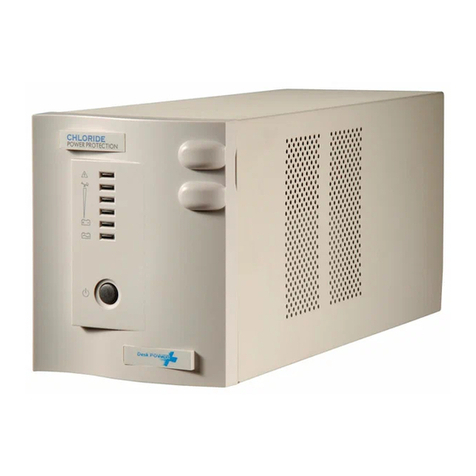
Chloride
Chloride Desk Power Plus 1000 User manual

Chloride
Chloride Power Star User manual
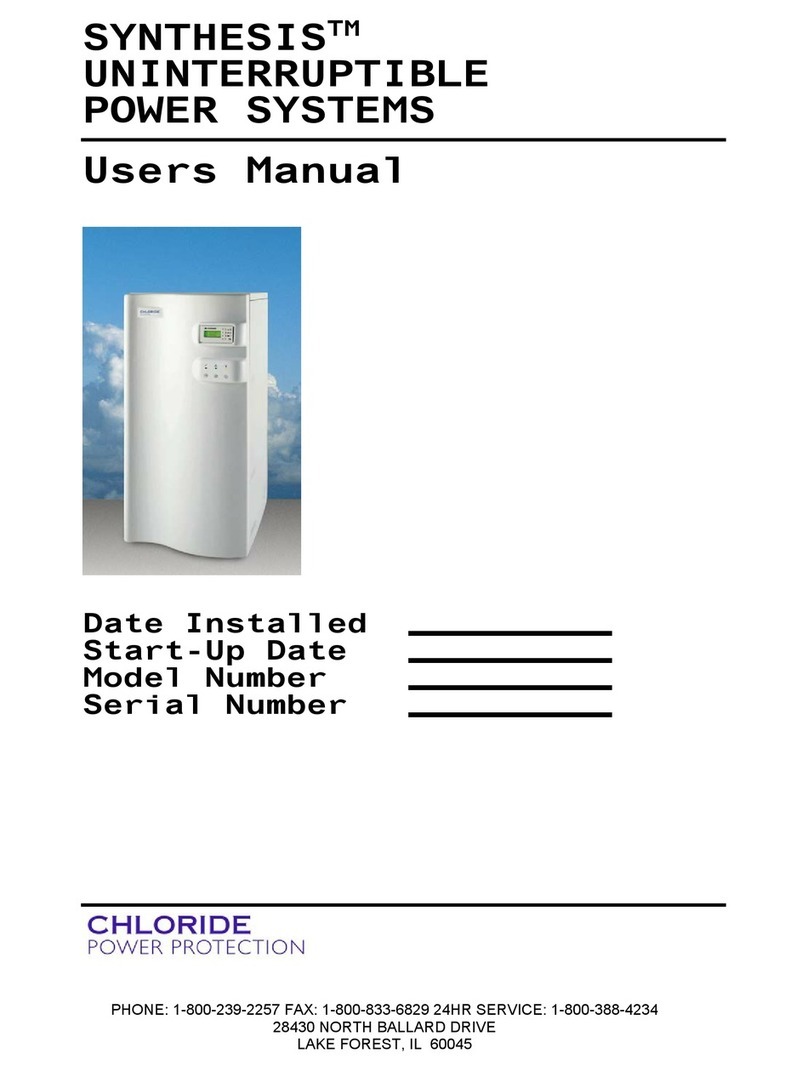
Chloride
Chloride SYNTHESIS User manual
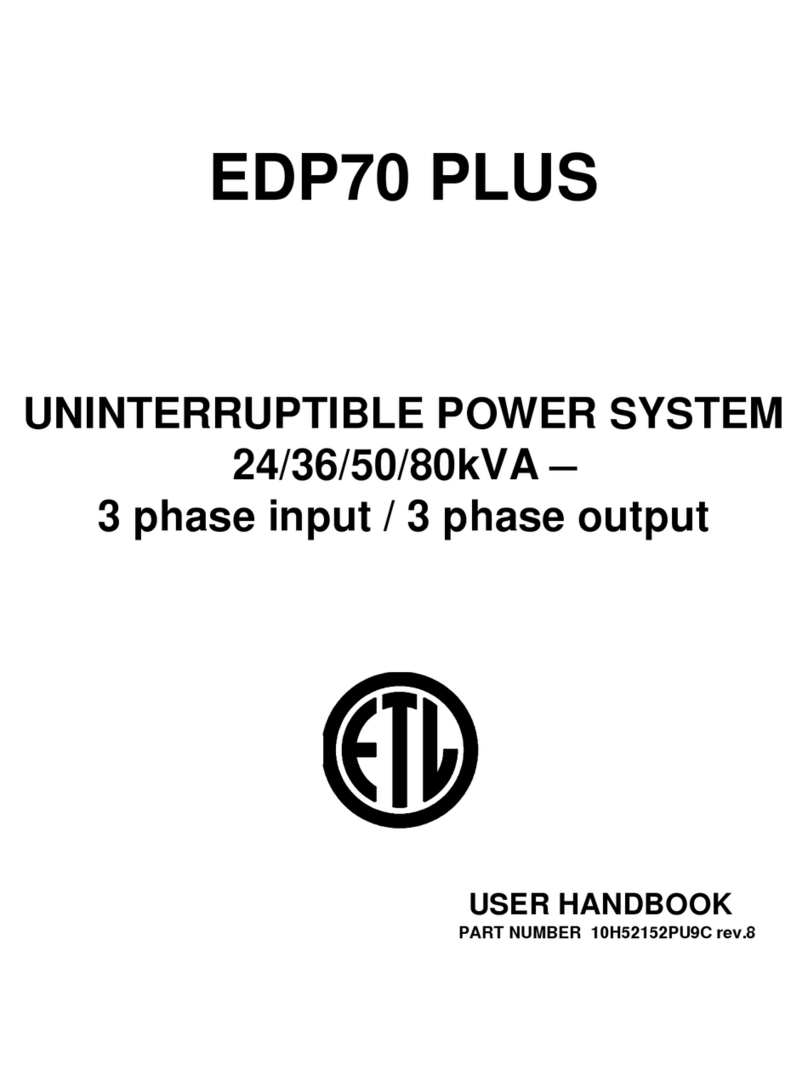
Chloride
Chloride EDP70 Instruction Manual
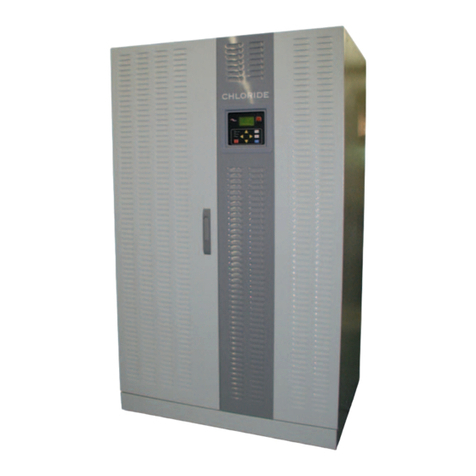
Chloride
Chloride CP3000 Series User manual

Chloride
Chloride ACTIVE A0K7XAU User manual

Chloride
Chloride Power Protection Active 700 User manual
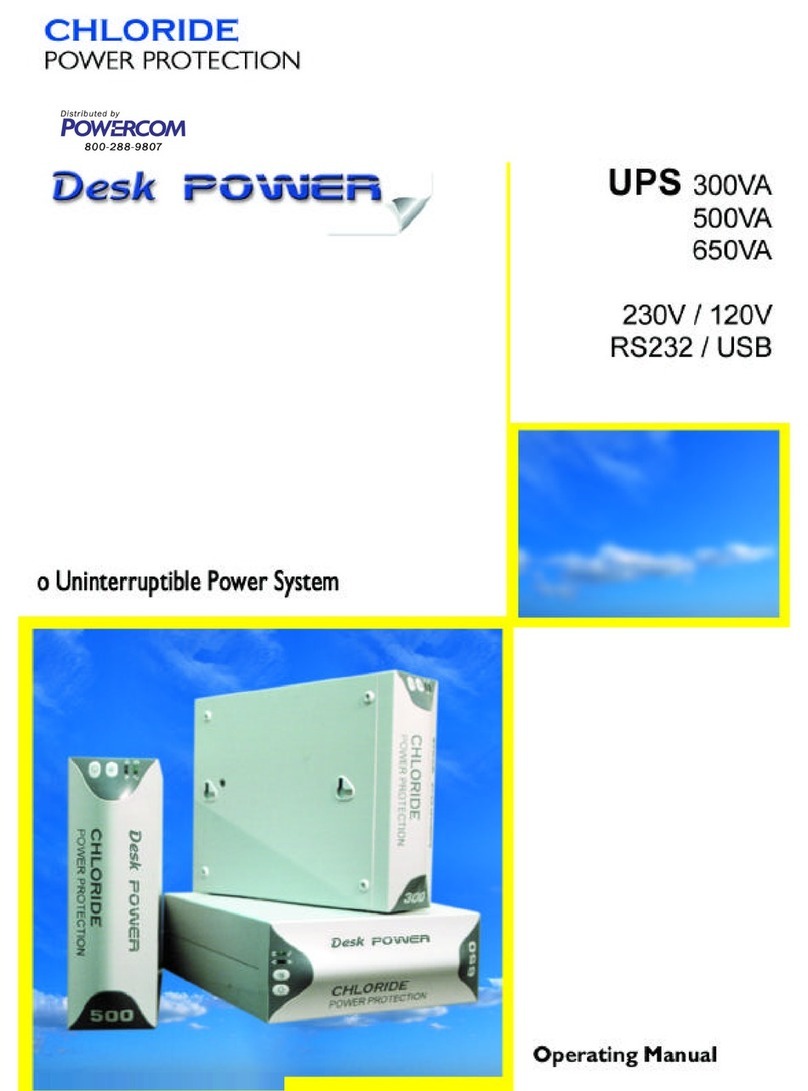
Chloride
Chloride Desk POWER 300 User manual
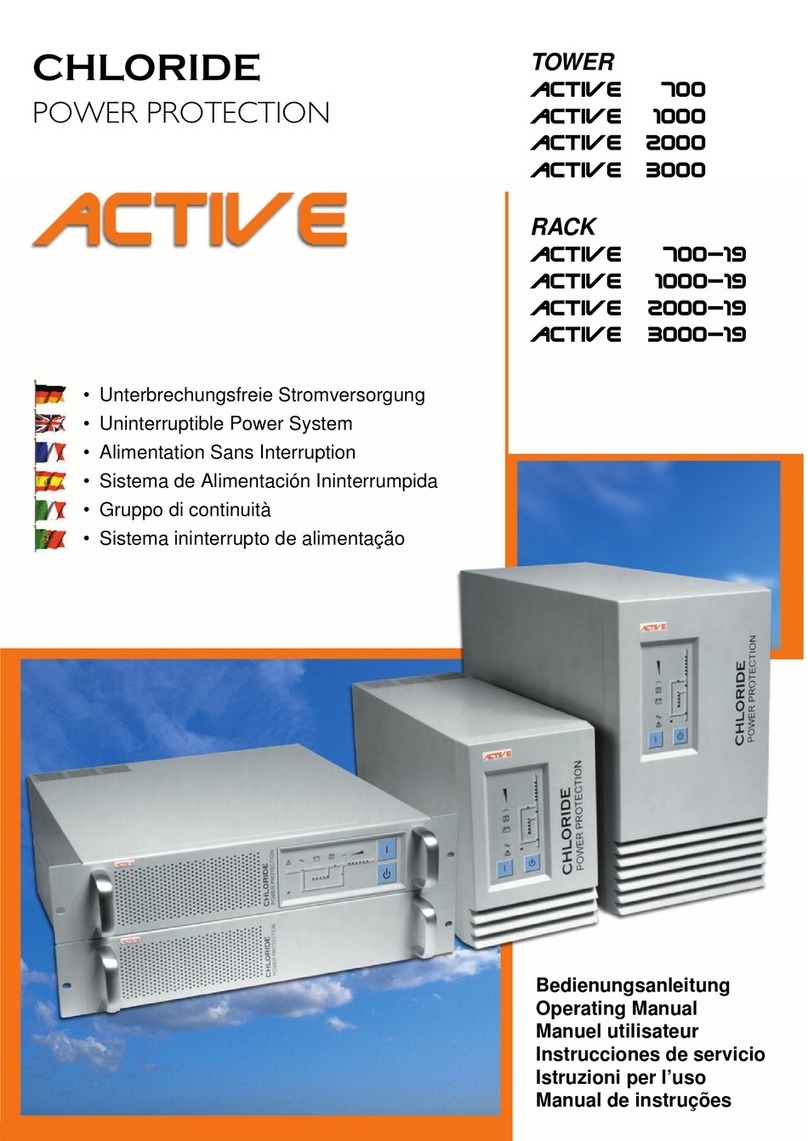
Chloride
Chloride Power Protection Active 700 User manual

Chloride
Chloride Power Protection Active 700 User manual
